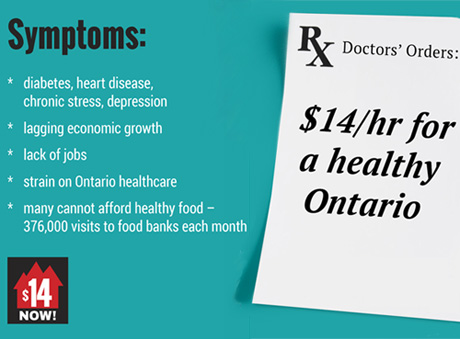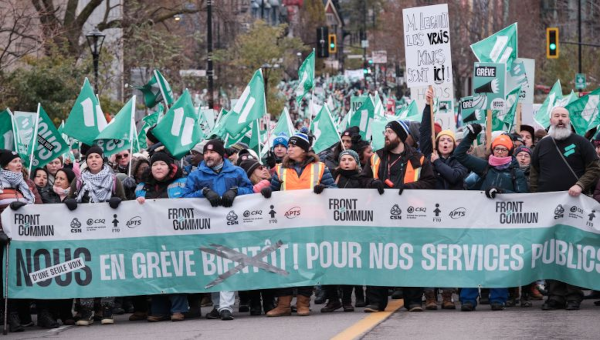Voters in Canada’s largest and most industrialized province went to the polls on June 5 to choose a provincial government. The choices were limited lesser evils, ‘bad,’ or ‘worse,’ constrained by a lurch to the political right by the union-based Ontario New Democratic Party (ONDP).
 This follows elections last year in Nova Scotia and British Columbia that were marked by the drift to the right of the NDP and electoral disappointments similar to what the party suffered in Ontario.
This follows elections last year in Nova Scotia and British Columbia that were marked by the drift to the right of the NDP and electoral disappointments similar to what the party suffered in Ontario.
By contrast, in the Quebec election earlier this year, voters had the choice of a left-wing party, Québec solidaire, and the party made modest gains. Though there are political weaknesses in the QS political platform (from a socialist perspective) and like the rest of the country, Quebec voters have no left-wing party to vote for federally, the existence of Québec solidaire provides an important experience in which to debate and apply policy and further develop a left-wing, anti-capitalist platform and direction.
So what was the recent experience in Ontario? What are the prospects for the political left in Canada to break out of the constraints of lesser evilism and forge a new party of the left?
The Election
Sitting on the political right in Ontario is the Conservative Party. Its campaign proposed to revisit the years of slash and burn to social services of former Premier Mike Harris. A key Conservative plank was to slash 100,000 jobs from the provincial civil service. The party proposed further privatization of government and social services.
Less stridently right-wing was the incumbent Liberal Party. Its election program feigned a socially progressive program (more on that later).
The Liberals’ ‘progressive’ ruse was made easier by the default of the New Democratic Party. As I reported at the beginning of the election, ONDP leader Andrea Horwath disappointed much of her party’s base by positioning herself to the right of the Liberals.
David Bush, an editor at Rank and File.ca, described the election outcome this way:
“The provincial election in Ontario was fundamentally about Tim Hudak’s austerity agenda, specifically his plan to cut 100,000 public sector jobs. There were of course local and regionally
differences in terms of what motivated voters, but ultimately this election was a referendum on Hudak’s plan.“And on that front what happened was positive. Ontario voted down the most pro-austerity party, and by and large labour’s campaign to stop Hudak worked. The Tories were thoroughly trounced at the polls.
“However, this anti-Hudak sentiment was translated into a Liberal majority. And it’s hard to celebrate four more years of Bay Street’s favourite party.”
Voter turnout surged by some 540,000 votes compared to the turnout in the 2011 provincial election which saw a record low turnout of 49 per cent. This time, the turnout climbed back to the 2007 level of 52 per cent of registered voters.
By the numbers, the Liberals increased their vote total by 238,000 and the ONDP by 163,000. The Conservative vote dropped by 24,000 votes. The Liberals won a majority government with 39 per cent of those who voted. The ONDP lost three seats in Toronto and gained three in smaller cities, to sit exactly where it was at the outset of the election (which the party triggered by voting against a Liberal budget) – 21 seats in the 107-seat Ontario Legislature.
Lesser Evil Illusions
The lesser-evil appearance of the Liberals is built on illusion. The party’s election platform was anything but progressive. Its key proposal is to create a supplementary pension plan due to federal government refusal to improve the Canada Pension Plan. But it remains a vague promise. Will an Ontario plan be a universal and defined benefit plan like the CPP? Or will it be a version of the defined-contribution investment fund (‘private pooled pension plan’) floated by the federal government some four years ago as a way to dodge pressure for CPP improvements? We do not know.
The Liberals have promised $15-billion to tackle the chronic public transit crisis in the Toronto region. Transit planning in Toronto is grossly in arrears and still there is no consensus on how to proceed. The Liberal transit proposals are modest – build a ‘relief’ subway line to ease subway congestion into the downtown core, expand an existing subway line in the Scarborough suburb, electrify existing suburban regional rail service, and expand regional rail service to several cities in the region.
Many transit experts consider the ‘relief’ subway line proposal to be misguided. They say expansion of suburban train corridors is key to transit improvement. A measure of that challenge is that the replacement of diesel powered trains with electrification alone will cost $2-billion and take more than ten years to realize. In a June 26 op-ed in the Toronto Star, urban affairs writer John Lorinc reminds Premier Kathleen Wynne, a former transportation minister, that the 30-year transit plan of Metrolinx, the regional transit authority in Toronto, is costed at $35-billion.
There is pressure on the Liberals from within for a new Toronto transit authority that would be a combination of privatized service and authoritarian, ‘not-for-profit’ management of the rest (similar to what has happened federally with ports and airports).
The Liberals say they will reduce the government’s $12.5-billion annual budget deficit to zero by 2017-18. That’s bad news for the poorest of society. There was nothing of substance proposed in the election to address the terrible lack of affordable housing in Toronto and other cities in the province or to improve miserly social welfare rates and services.
Before the election call, the Liberals had already frozen the wages and benefits of public sector workers and announced plans to cut pension benefits.
The failures in tackling transportation, housing and other pressing social needs in Toronto have been amplified by three wasted years of the train wreck known as Mayor Rob Ford. His governing clique has been aided and abetted by the highest echelons of the Conservative Party and government in Ottawa, including the man Ford has called his “fishing partner,” Stephen Harper, and the late, long-serving Finance Minister Jim Flaherty who “campaigned hard” for Ford in the 2010 municipal election.
Prior to announcing the election, Premier Wynne responded to pressure for a radical increase to the minimum wage by raising it to $11 per hour. “Not good enough,” says the union-supported ‘$14 Now!’ campaign. It says it will continue its monthly rallies and outreach blitzes that began in March of last year.
The Workers Action Center in Toronto issued a statement on June 6 saying, “it is more important than ever that we build our power to hold elected officials to their promises and to win
fair wages and decent work. Let’s start with a powerful community delegation to remind the new Minister of Labour that over one million workers in Ontario need a raise to $14 now!” [See June 18th event.]
The largest part of the provincial budget – 42 per cent of total spending – is healthcare delivery, $50.1-billion in 2014-15. Hospital budgets were frozen in 2012-13 or 2013-14 and the reelected government says the freeze will remain in place.
Two large parts of that spending are Liberal initiatives in recent years that Toronto Star columnist Martin Regg Cohen calls “unproven and controversial ventures” – Local Health Integration Networks, which decide on the financing of hospitals ($24-billion annually), and Community Care Access Centers (CCACs), which deliver home care (nearly $2-billion annually).
An example of wasteful and abusive health spending are the salaries of CCAC executives. Fifteen top executives who run Ontario home care were paid nearly $4-million in 2012, the most recent year that salary data is available. That’s an average of $266,000 each. The association of registered nurses in the province wants an end to CCACs, calling them an expensive duplication of services.
NDP Shift to the Populist Right
The ONDP election campaign borrowed on right-wing, populist themes. Its slogan – ‘Makes Sense’ – bizarrely harkened to the harsh ‘Common Sense Revolution’ austerity program of the Harris Conservative years of the late 1990s and early 2000s. The party campaign focused almost exclusively on condemning the Liberals for several of their pet projects that wasted billions of dollars – notably the Ornge ambulance transport service the government created, and cancelled construction of several natural gas electricity stations intended to replace coal-fired stations. Because the ONDP chose to focus so much of its attention on scandal, the Liberals appeared more receptive to the big concerns of many voters – jobs and the economy, transit, public spending and debt, etc.
Horwath was silent during the considerable public debate on the minimum wage that preceded the election. She came out in support of $12 late in the election. She opposed Liberal talk of pension improvements, saying these should come from the federal government. But the federal government has been refusing for years to make any improvements to the CPP. Aping its big business supporters, the government calls public pension fees a “payroll tax.” Horwath could have used her election campaign to urge a fight for pension improvements instead of passively giving in.
Like the Liberals, Horwath’s main economic proposal was to financially reward companies that invest in the province. She also threw in some cheap, populist ‘pocketbook’ proposals to reduce selected fees and taxes.
Added to last year’s NDP election losses in Nova Scotia and British Columbia, the Ontario vote spells bad news for prospects for the party in next year’s federal election. The Liberals in Ontario proved able to put on a pretend left face at very little cost to themselves and the wealthy class they represent. A similar performance by the federal Liberals is now more likely than ever.
It won’t take much for them to appear to the left of Stephen Harper’s Conservatives. There is a deepening disaffection by a large majority of the population with the Conservatives. This will create intense pressure on working-class voters to select the ‘lesser evil’ with the best chance to defeat Harper.
In the 2011 federal election, the NDP won a stunning breakthrough in Quebec by winning 59 of the 75 seats there. That catapulted the party into official opposition status in the federal Parliament. The unique circumstances that created that breakthrough in Quebec – the simultaneous discrediting of the Liberal Party and the pro-Quebec sovereignty Bloc québécois – are less acute. Indeed, the rather easy victory of the discredited Quebec Liberals in the Quebec election three months ago is a further indicator of the NDP’s tenuous hold on second-party status in Ottawa.
Left Alternative Needed
After four years of right-wing Conservative government in Ottawa, there will be strong ‘anybody but Conservatives’ (ABC) pressure at play next year on the large majority of adults who do not vote Conservative. Many progressively inclined voters will be inclined or cajoled to choose between the NDP or Liberals, including choosing which among the two is most likely to win each, specific electoral district.
The Liberal Party should be rejected out of principle. It is one of the twin parties of Bay Street. But the NDP is no better than a lesser-evil option. Federal NDP leader Tom Mulcair made a not-so-subtle reminder of this in a recent interview in which he reaffirmed his ideological devotion to the right-wing, social democratic example and legacy of former British prime minister Tony Blair. Mulcair has also affirmed his support for destructive fossil fuel projects that will worsen the climate crisis, including the Energy East and Line 9 pipelines that would bring Alberta tar sands bitumen to eastern Canada for export to foreign markets.
The right drift of all the provincial NDP sections is increasingly pronounced. In British Columbia, the party responded to last year’s harsh electoral loss by choosing a new leader, John Horgan, who is devoted to more, destructive resource extraction projects such as natural gas fracking, clearcut logging and mining. He supports the use of BC ports for expanded coal exports to Asia and does not rule out tar sands pipelines to the BC coast provided they include “environmental safeguards.”
In New Brunswick, the NDP is undergoing a sharp shift to the right in which two sitting members of the provincial legislature from the Conservative and Liberal parties have been approved by the party leader as candidates in the next provincial election. The president of the NDP district association where the Conservative is to run has quit, saying he wants out of the “Un democratic party.” He says, “I’ll be back when the reign of terror is over,” referring to NDP leader Dominic Cardy’s sharp right turn.
So a new, left-wing and anti-capitalist political direction and party is needed. That’s a key lesson to draw from the Ontario election and from the experiences in other provinces. It is needed for evident social and environmental reasons. It’s also a way to sharpen a fight for political accountability in the present political alignment. Extra-Parliamentary protests are vital in fighting for reforms and creating a political alternative. But it’s a big weakness when there are no anti-capitalist voices in the electoral arena. That leaves the pro-capitalist NDP holding a political monopoly on the left. (A similar argument, on a smaller scale, applies in the environmental arena with respect to the pro-private enterprise Green Party.)
Such an alternative, at the ballot box and in the streets, would also address the growing disaffection of young and working-class people from political engagement. While the official voter turnout in this latest Ontario election was 52 per cent, that number does not account for some one million adult-age persons who do not register to vote. That means the real participation rate in the election was in the lower 40 per cent range. A disproportionate number of those not registering to vote are surely young and working-class voters.
The disaffection of young people from the electoral process is a worldwide phenomenon and should be a concern for any serious party or political project. Youth are the hardest hit by rising unemployment, the narrowing access to higher education, the high cost of urban transport, the decline of public healthcare, and so many other manifestations of declining capitalism. They are vulnerable to the consumerism and other false values that capitalism projects so powerfully. They will be especially receptive to a political project that can address their two largest concerns – meaningful jobs and economic stability, and the fate of the Earth and its ecology.
An anti-capitalist party and political platform would also appeal to the great many NDP supporters who are anti-capitalist in their outlook. Here are
some proposals that a movement of mass, political mobilization needs to fight for:
- improving the Canada Pension Plan, restoring cuts to the unemployment insurance program and creating a national child care program
- increasing social welfare incomes and services, including a vast program to build social housing
- changing the discredited and deeply discriminatory temporary foreign worker program such that every foreign worker coming to Canada has a path to citizenship
- preserving postal services, including door to door delivery, and expanding rail service throughout the country
- investing in the vast societal shift needed to end the reliance on fossil fuels and end all the excess and waste that is driving global warming
- financing needed social and environmental improvements by raising taxes on the wealthy, drastically cutting the military budget and nationalizing the banks
- withdrawing Canada from imperialist military alliances such as NATO and from military adventures such as in Ukraine and eastern Europe. Promoting Canadian solidarity with the Non-Aligned Movement, the UN Group of 77 countries + China and the Community of Latin American and Caribbean States (CELAC). For Canadian withdrawal from the Organization of American States
- decentralizing governing institutions in favour of local democracy
- convening a constituent assembly to rewrite the Canadian constitution, including abolition of the unelected Senate and recognition of self-determination and political sovereignty for Quebec and First Nations
Unity around such a broad platform will be difficult to achieve, but it can be done if the campaigns around which working-class people are organizing simultaneously develop political visions. It’s no coincidence that Québec solidaire has arisen before something comparable in English Canada – the party’s development is propelled by a shared vision of a progressive, sovereign Quebec and a government that can lead a fight to win that. And the results of elections to the European Union in May were very encouraging in a number of countries, including in Greece and Ireland where Syriza and Sinn Fein topped the polls, respectively, and in Spain where the brand new party Podemos (We Can) captured eight per cent.
Socialist society offers to the individual a path to realize his and her full human potential. To get there, we need a revolutionary, democratic government that carries through a transformation of politics and economics one confident step at a time. That’s the appealing prospect around which the socialist and anti-capitalist left should cohere so that we needn’t endure another, dreary election spectacle in which the only meaningful choice is ‘none of the above.’ We owe it to ourselves and to the planet to do better than that. •





